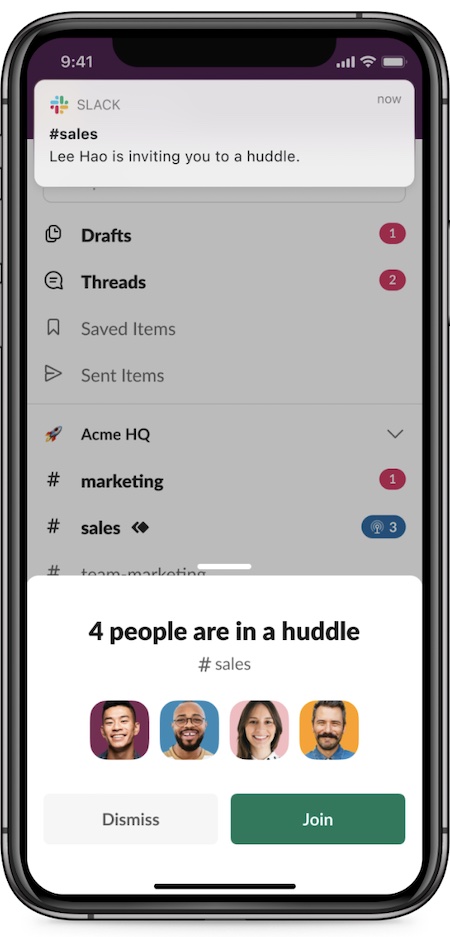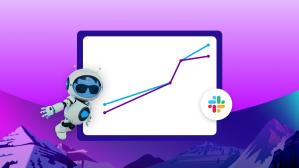Despite all the disruptions to our working lives in the last couple years, one thing has become clear: we’re not going back to the old ways. The pandemic has accelerated the already ongoing transition from the physical office to the digital HQ, helping employees, customers and partners to connect, work, and even socialize. But this road to the future of work hasn’t been without its bumps. We need to keep prototyping new ways to get work done and create a sense of belonging.
New challenges, new customer opportunities
In the early days of the pandemic we mostly “lifted and shifted” the old ways from the office to the living room. After the initial shock passed and we realized remote and hybrid work were here to stay, we settled into that change. At Slack, we used data and customer feedback to reshape our product with a special focus on flexible, inclusive, and connected ways of working.
Our goal is to make Slack a workplace tool that’s human-centric. We work to develop thoughtful, intuitive products that help people focus more on their work, while making it a little more enjoyable. From sharing practices that can better reflect our reactions and personality, to using custom integrations that make work easier, our users take 15 billion actions per week.
We are enabling our customers to be “digital-first,” to empower teams to work when, where, and how it’s best for them, while still feeling connected. That’s why we recently released Slack Huddles, an easily accessible, audio-first way to communicate inside a Slack channel or direct message, including channels with external partners. This is a tool to connect you with the right people — right where you’re working. The typical huddle lasts 10 minutes, offering teams an alternative to lengthier video calls. It’s the digital equivalent of tapping someone on the shoulder.

Slack Huddles is actually our fastest-adopted feature. We knew it would resonate with workers in the current environment, but it took off so quickly and got such a positive buzz on Twitter and social channels that even we were surprised. But this innovation isn’t an isolated pandemic-era trend that served people’s temporary needs; instead, it is already becoming a permanent fixture in the working lives of many customers, including Dell and Tibco.
Another digital-first tool that we’ve added to our product is Slack Clips, which allows you to create and share video, voice, and screen recording in Slack. Clips solve for that frustrating tradition of juggling calendars for a meeting — or when it’s just not necessary to meet at the same time. Instead, you can record and share a clip right in-channel with a project update, presentation, or feedback, and your colleagues can respond whenever it works for them. Clips allow people to communicate with nuance and emotion in a way that text alone can’t – fostering connection and collaboration. As you can imagine, this tool has been invaluable for distributed teams working across timezones.
Automation is another big part of unlocking the power of the digital HQ. In the past, technical teams alone tackled building apps and tools. But, now we’re entering an era where software makes it possible for everyone – developers and non-developers alike – to automate repetitive tasks, freeing up time and energy to focus on more important, creative, human work.
At Slack, our goal is to make automation on our platform as easy as building with Legos — and maybe just as fun. From streamlining legal review processes to approving direct reports’ PTO requests, everyday users can automate work — no training needed.
Since we launched our Workflow Builder, for example, more than 400,000 users have built workflows and 80% of those using the tool come from non-technical backgrounds. And soon we’ll be giving developers the ability to create workflow building blocks so that anyone can pull them from a gallery and drag and drop them in place to create highly customizable workflows right in Slack.
We’re creating a movement of developers and every-day business users in Slack who are creating the next generation of apps and workflows.
The promise of a digital HQ will only be realized if we can seamlessly and securely collaborate with others internally and externally. That’s why we created Slack Connect, which provides a faster, more flexible way for people to work alongside partners, vendors, or customers by moving conversations out of siloed email threads and into the same place. We’ve seen tremendous momentum with Slack Connect with customers like IBM, Target, and T-Mobile. A full 77 of the Fortune 100 companies rely on it to foster relationships with customers and collaborate with external partners.
In everything we do, we’re looking at the long-term impact to achieve a more simple, pleasant and productive work environment for our customers. We want all of our customers to thrive on Slack. And as the ecosystem of how we work continues to evolve, we need to change what we’re doing to make sure that we’re staying ahead of the needs of our customers.
The exponential power of combining platforms
We are also bringing Slack’s digital HQ for employees and partners together with Salesforce’s digital HQ for customers. Users will now have Salesforce’s Customer 360 single view right in Slack. This means that organizations can tap into Salesforce’s customer data and business insights, in Slack channels, where their teams are already working. Closing these gaps between data about the business and people working on the business means that teams can work faster together, make smarter decisions, and simplify processes.
But what does this look like? Imagine a salesperson is working in Slack. Seventy percent of their day is spent communicating with their teams, and/or collaborating with their customers and partners. With Sales Cloud for Slack, updates from opportunities are pushed automatically into a Slack channel, where their account team can discuss how to make sure the sales deal gets to “closed won” and make decisions about next steps, or even edit the deal record. All of the edits they make and actions they take sync back into Salesforce, so Slack and the Customer 360 are constantly enriching each other. And with everyone working in the same place, it’s easier than ever for the broader teams, like finance and legal, to get involved with — and collaborate around — the opportunity for questions or approvals.
A recent study from Forrester found Slack integrations in Service Cloud lead to an 11% improvement in customer satisfaction scores. If someone is using Service Cloud for Slack, they can create a swarm with subject matter experts who are available directly within Slack and solve problems with them, without switching back-and-forth between Slack and Service Cloud.
According to Clara Shih, Salesforce’s Service Cloud GM: “Say an e-commerce site just went down and customers can’t log in. The agent can’t fix this on her own, so she can spin up a Service Cloud swarm in Slack with the DevOps and engineering teams to get the site back up as quickly as possible.”
Many companies are finding that the combination of Salesforce’s Customer 360 and Slack’s digital HQ tools are making a meaningful difference. For example, Intuit reports that its Salesforce- and Slack-powered digital HQ has helped boost customer service ratings by 12%.
Where we’re headed
People have experienced the freedom, flexibility, and work/life balance that comes from working when and where it’s best for them. Our Future Forum research shows that 78% of workers want flexibility in where they work and 95% want more flexibility when they work. But just because you’re working remotely doesn’t mean you never see others in person. It’s not one or the other. There may be offsite meetings and visits to the office for certain activities or bonding, for example.
We are not temporarily trapped in some kind of chimera that will suddenly disappear, landing us right back in our old versions of the workplace. Permanent changes are afoot, and meaningful innovation is here, now, with more to come.
I am positive that the technology solutions that make us productive when working remotely are still works in progress. The opportunity to help our customers stretches out as far as the eye can see. We’ve got a lot more that we can do — that we’re prototyping right now. At Slack we envision more automation with our platform, more forms of asynchronous communication, greater integration with other products, and better communication tools that are less tiring. I think we will see an evolution in software and technology platforms to help us make hybrid and distributed work better, more energizing, and more connected.
More information:
- Read about Salesforce and Slack’s vision for the digital HQ — right from the founders of both companies.
- Learn how Intuit tapped Salesforce and Slack to build its digital HQ.




















